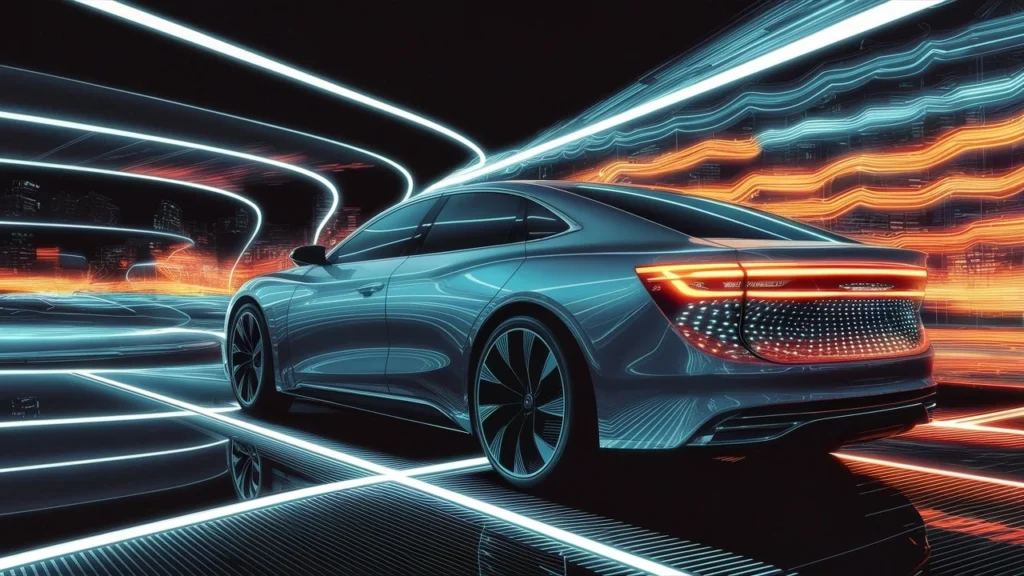The automotive industry is on the brink of a lighting revolution. Traditional halogen headlights, once the norm, are being swiftly replaced by cutting-edge technologies that promise more than just illumination. Today, LED (Light Emitting Diode) and OLED (Organic Light Emitting Diode) technologies are leading the charge, transforming not just the way cars look but also how they function. These advancements offer greater efficiency, enhanced safety, and limitless design possibilities, making them essential in the evolution of modern vehicles.
Understanding these technologies and their implications for the future of automotive lighting is crucial, whether you’re an industry professional, an enthusiast, or simply someone curious about where automotive technology is headed.
The Rise of LED Technology
History and Development of LED in Automotive Lighting

LED technology first appeared in the automotive world in the early 2000s, primarily in high-end vehicles. Initially used in brake lights and indicators, LEDs quickly gained popularity due to their efficiency, durability, and ability to be incorporated into intricate designs. Unlike traditional halogen bulbs, which rely on heated filaments to produce light, LEDs generate light through a process called electroluminescence. This process not only uses less energy but also produces a brighter, more focused light.
Benefits of LED Over Traditional Lighting Systems
The benefits of LEDs in automotive lighting are manifold:
- Energy Efficiency: LEDs consume significantly less power than halogen bulbs, contributing to improved fuel efficiency and reduced emissions in vehicles.
- Durability: LED lights have a much longer lifespan, often outlasting the vehicle itself. They are also more resistant to shocks and vibrations, making them ideal for automotive use.
- Design Flexibility: LEDs can be arranged in various shapes and sizes, allowing designers to create more innovative and distinctive lighting patterns. This flexibility has led to the creation of iconic lighting designs in many modern vehicles.
- Instant Illumination: Unlike traditional bulbs that take time to reach full brightness, LEDs light up instantly, improving reaction times in safety-critical applications like brake lights.
Current Applications and Examples of LED Use in Modern Vehicles
Today, LEDs are ubiquitous in modern vehicles. From headlights and taillights to interior ambient lighting, LEDs are used extensively to enhance both functionality and aesthetics. Notable examples include the Audi A8 and the BMW 7 Series, both of which feature advanced LED headlight systems capable of adaptive lighting. These systems can adjust the light pattern based on driving conditions, enhancing visibility and safety.
In addition, the use of Matrix LED technology allows for even greater control over the lighting. This technology divides the light emitted by the LED into individual segments, each of which can be turned on or off independently. This enables precise lighting that can avoid dazzling oncoming drivers while still providing excellent visibility.
OLED Technology: The Next Frontier
Introduction to OLED Technology and How It Differs from LED

While LEDs have become standard in automotive lighting, OLED technology represents the next big leap. OLEDs, or Organic Light Emitting Diodes, differ from LEDs in that they use organic compounds that emit light when an electric current is applied. This allows OLEDs to produce light without the need for a backlight, which is a key advantage over LEDs.
Advantages of OLEDs: Flexibility, Design Possibilities, and Energy Efficiency
OLEDs offer several unique advantages:
- Thin and Flexible: OLEDs can be made ultra-thin and flexible, opening up new possibilities for automotive design. They can be seamlessly integrated into curved surfaces, allowing for more innovative and aerodynamic designs.
- Uniform Lighting: OLEDs produce a soft, diffused light that is evenly distributed across the surface. This makes them ideal for creating visually appealing lighting effects, such as continuous light strips that can enhance a vehicle’s exterior and interior aesthetics.
- Energy Efficiency: Similar to LEDs, OLEDs are highly energy-efficient, contributing to the overall reduction in a vehicle’s energy consumption. They also generate less heat, which can be advantageous in certain applications.
- Customization: One of the most significant advantages of OLEDs is their ability to be customized. Different lighting patterns and colors can be achieved with OLEDs, allowing for greater personalization and brand differentiation.
Case Studies of Automotive Companies Adopting OLED (e.g., Audi, BMW)
Leading automotive brands are already experimenting with OLED technology. Audi has been at the forefront of this innovation, incorporating OLEDs into the taillights of its vehicles. The Audi Q5 is one of the first production vehicles to feature OLED technology in its taillights, offering dynamic lighting patterns that change based on driving modes or user preferences.
BMW has also adopted OLED technology, particularly in its concept vehicles. The BMW M4 GTS features OLED rear lights, providing a glimpse into the future of automotive lighting design. The thinness and flexibility of OLEDs have allowed BMW to experiment with more radical and futuristic designs, setting the stage for what’s to come.
Comparative Analysis: LED vs. OLED

Technical Comparison of LED and OLED Technologies
When comparing LED and OLED technologies, several technical differences stand out:
- Structure: LEDs are point light sources, while OLEDs are surface light sources. This means LEDs are better for focused lighting, like headlights, whereas OLEDs excel in creating uniform, ambient light.
- Brightness: LEDs typically offer higher brightness levels than OLEDs, making them more suitable for applications where intense light is needed, such as in headlights or daytime running lights.
- Durability: LEDs are generally more durable and have a longer lifespan compared to OLEDs. However, advancements in OLED technology are closing this gap.
- Flexibility: OLEDs are inherently more flexible and can be applied to curved or irregular surfaces, unlike LEDs, which are more rigid.
- Cost: Currently, OLEDs are more expensive to produce than LEDs, which has limited their widespread adoption. However, as production methods improve and economies of scale are achieved, the cost of OLEDs is expected to decrease.
Application-Specific Advantages: When to Use LED vs. OLED
The choice between LED and OLED often depends on the specific application:
- LEDs are ideal for applications requiring high brightness and durability, such as headlights, fog lights, and brake lights.
- OLEDs are better suited for applications where design flexibility and uniform light distribution are essential, such as in taillights, interior lighting, and ambient lighting systems.
Cost and Manufacturing Considerations
The cost of implementing OLED technology remains a significant challenge. While the benefits of OLEDs in terms of design flexibility and energy efficiency are clear, the high production costs have limited their use to premium vehicles. However, as the technology matures and production becomes more efficient, it is expected that OLEDs will become more accessible, even in mid-range vehicles.
The Future of Automotive Lighting: Trends and Predictions
Emerging Trends in Automotive Lighting (e.g., Smart Lighting, Adaptive Systems)
The future of automotive lighting is set to be dominated by smart and adaptive systems, where both LED and OLED technologies will play crucial roles. Smart lighting systems use sensors and AI to adjust lighting based on real-time conditions. For example, adaptive headlights can change the direction and intensity of the light beam based on the car’s speed, steering angle, and road conditions.
OLED technology is also paving the way for more personalized lighting experiences. With OLEDs, drivers can customize their vehicle’s lighting to match their preferences, from the color and intensity to the patterns displayed.
Predictions for the Adoption of OLED in Mainstream Vehicles
As the cost of OLED production decreases, it’s expected that OLED technology will become more common in mainstream vehicles. Within the next decade, we could see OLEDs being used not just in premium models but across a wider range of vehicles, particularly in applications like taillights and interior ambient lighting.
The Role of Lighting in Autonomous and Electric Vehicles
As the automotive industry moves towards autonomous and electric vehicles, lighting will play an increasingly important role. For autonomous vehicles, lighting will not only be about visibility but also communication. For instance, OLED panels could be used to signal a vehicle’s intentions to pedestrians and other road users.
In electric vehicles, where energy efficiency is paramount, both LED and OLED technologies will be crucial in minimizing power consumption while still providing the necessary illumination and aesthetic appeal.
Challenges and Opportunities
Technical Challenges in Adopting OLED for Automotive Use
While OLEDs offer many advantages, several technical challenges remain:
- Durability: OLEDs are more sensitive to environmental factors like moisture and temperature, which can affect their longevity in automotive applications.
- Brightness: Achieving the same brightness levels as LEDs, especially in applications like headlights, is still a challenge for OLED technology.
- Cost: As mentioned earlier, the high cost of OLEDs remains a barrier to widespread adoption.
Market Dynamics: Cost, Consumer Acceptance, and Regulatory Issues
Consumer acceptance of OLED technology is growing, particularly as more premium vehicles showcase its potential. However, for OLEDs to become mainstream, costs need to come down, and manufacturers must address the technical challenges.
Regulatory issues also play a role. As new lighting technologies emerge, regulations governing their use and safety standards will need to evolve to keep pace with technological advancements.
Opportunities for Innovation and Design
The potential for innovation with OLEDs is vast. As the technology improves, designers will have even more freedom to create unique, eye-catching lighting solutions that not only enhance a vehicle’s appearance but also improve safety and communication.
OLEDs could also lead to new forms of vehicle interaction, where lighting becomes a medium for conveying information, both inside and outside the vehicle.
Conclusion
The future of automotive lighting is bright, with both LED and OLED technologies set to play pivotal roles. LEDs, with their efficiency and durability, will continue to be the workhorse of automotive lighting, while OLEDs, with their design flexibility and customization potential, represent the next frontier. As these technologies evolve, they will not only enhance the aesthetics and functionality of vehicles but also contribute to safer, more efficient, and more personalized driving experiences.
The automotive industry is just beginning to explore the possibilities of these technologies. As costs decrease and challenges are overcome, we can expect to see even more innovative and sophisticated lighting solutions in the vehicles of tomorrow.







